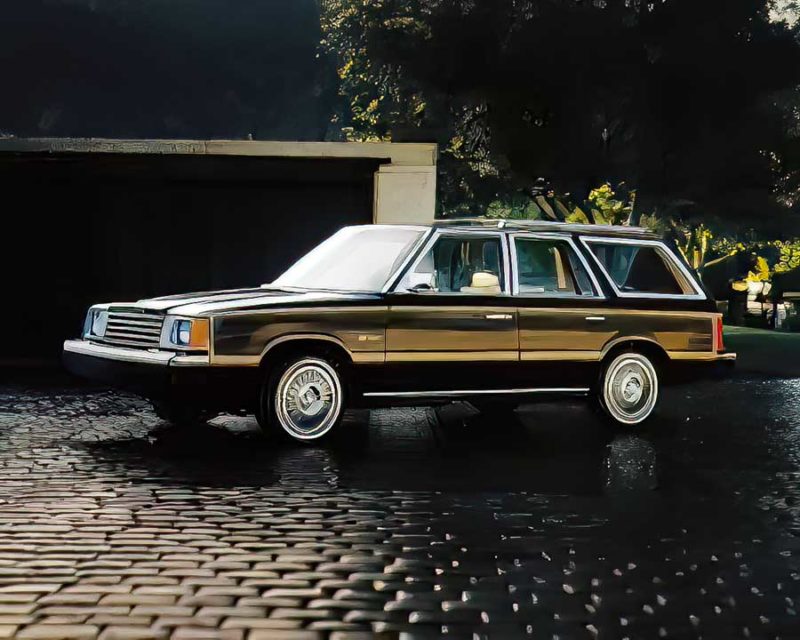The USA variant of the Kei car. So twice as heavy as the Japanese and with more thirst, but just as nice: the Dodge Aries.
With sister model Plymouth Reliant and some derivatives, these models formed the famous K-series of Chrysler, named after the platform of this compact† By American standards then. There were smaller models, such as the Dodge Omni (our Simca-Talbot Horizon). But they were hardly taken seriously by our overseas friends. Nice for students, some clumsy housewives or shaky elderly people without Cadillac. The Dodge Aries was a step up and, more importantly, real american steel.
Modern and well-arranged design
It just needed much less. At less than four and a half meters long and weighing barely 1100 kg, the Dodge Aries was modest in its proportions. That was quite un-American. But his appearance and character made up for a lot. It was modern and clearly designed, and especially the station wagon with typical wood trim remained recognizable as a real American. One woody with whitewalls and spoke caps: this way, you even get Average Joe hot for downsizing.
Redding
And that was a good thing. Because at the time of the introduction of this K-series Chrysler was in heavy weather. As a result of the energy crisis, which gas guzzling made six or eight cylinders unpopular, Japanese car manufacturers began to eat more and more thoroughly from the American rack. That shook Chrysler, but this K-platform proved to be the rescue. More than 1981 were sold between 1989 and 3.500.000. Soon the Dodge Aries and its derivative Dodge 400 and 600, the Plymouth Reliant and Caravelle and also the Chrysler LeBaron and New Yorker together helped the ailing Chrysler completely out of the red. The balance was positive again and so were most buyers.
Mix of American ideas and European ideas
That was absolutely right, the Dodge Aries combined compact economy with their beloved American way of driving† Of course with much less soft driving characteristics than the mastodons of yesteryear. But it still had such a flat, wonderfully cluttered and fake wood dashboard with a firm lever on the steering column, a front seat and then an absolute must: a steep rear window. The technique was also a popular mix of traditional American ideas and somewhat more modern European ideas. In the front, a 2.2 liter four-cylinder quietly whirred with a real American power: 84 HP. Yep. Later in his career this increased to 94 HP. Watch out.
Subscribe now and pay only € 3,75 per song instead of € 5,99
Made in the USA
Optionally, a 2,6 liter Mitsubishi was also available, which became the Hemi models. Just like Chrysler's own block, a four-cylinder, but the Japanese variant often turned out to be less reliable and more leaky than the homemade engines. †Told you so', Average Joe must have boasted. Anyway, all variants drove the front wheels, the Dodge Aries had a rigid axle at the rear. Americans felt at home in it, but Europeans also coped better with it than with the traditional 40-foot container-sized cruise-o-saurs. Without denying his heritage, he remained recognizable as made in the USA. And you couldn't believe it, but the Dodge Aries had been in the wind tunnel for a whopping 320 hours in its development phase. Perhaps the parking lot had been full.
The one at the template in any case, in all shapes and sizes you came across the Aries: as a sedan, two-door coupe or station wagon. In total, almost a million units were sold of this compact Dodge, which turned out to be bigger than it looked and yet remained extremely modest. Basically a boulder of a car.
Also read:
- Plymouth, Dodge and Oldsmobile police cars
- The Chrysler Simca Horizon (Dodge, Plymouth, Sunbeam)
- Dodge Aries





My father bought a new one built in 1986, a 2.2l 4cyl automatic transmission, we actually had no problems with it, no motor, no gearbox, paint etc. all working well for years.
Shortly after the car was purchased from Koni, we had other shock absorbers fitted, which was a good improvement, and did not sag when loaded. And once a computer module was replaced, the engine continued to run but the fuel consumption increased. When the new module was installed, the engine ran perfectly again and fuel consumption returned to normal. 1 out of 11 was just achievable.
Years ago I took a test drive in an occasion of a few years old.
The visible rust was already noticeable, but the 2,2 liter block faltered and stuttered.
So returned quickly and fled.
Also a shame, because the American design looked nice…
They were even worse than the GM-X cars, and that seemed almost impossible. They were cheap and could take 6 years to pay off. Lee's child prodigy, ouch.
By the time they were almost paid off, they literally fell apart. There was absolutely nothing
well, even the mirror on the sunvisor gave a distorted image. The horror, the love child
or Pee-wee Herman and Dame Edna. brrrrr.
I don't know where you got your information and experience from, but it doesn't make any sense. The Chryslers were good, reliable and the lack of knowledge in European garages, yes that was a big problem. The quality was simply good for American cars.